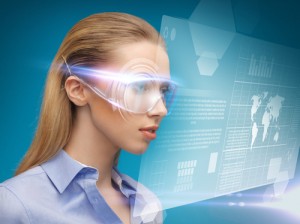Virtual and augmented reality shopping hits the high street
 Virtual reality (VR), a computer-simulated 3-D environment viewed through a computer screen or wireless glasses, or augmented reality (AR), which uses technology to alter the physical environment by adding sound, images or words to enhance the real-world experience, is on the retail agenda.
Virtual reality (VR), a computer-simulated 3-D environment viewed through a computer screen or wireless glasses, or augmented reality (AR), which uses technology to alter the physical environment by adding sound, images or words to enhance the real-world experience, is on the retail agenda.
Currently the technology has more of an ‘event’ style presence as managers try to see what the value is and how to exploit it, but with development it may well become part of the everyday shopping practice to:
- Provide additional information about a product or service in order to give consumers the power to make better buying decisions.
- Offer better customer service by helping a customer navigate around a store, so that shoppers are no longer searching up and down aisles to find things.
- Present promotional activities of potential special interest or try before you buy services to gain extra customer interest and interaction.
“In five years, you will not walk into a retailer and get lost,” said Barbara Barclay, general manager of North America for Tobii, an eye-tracking technology company with offices in Mountain View, Calif. “They’ll know who you are and what your last shopping experience was. They will know where you’re looking on a shelf. The whole shopping experience in five years will be highly personalised.”
Lately retailers have been exploring a technology known as Oculus Rift to give customers the ultimate retail experience. The technology has the ability to create an entirely virtual shopping experience or one with physical aspects, and is expected to become a part of the retail experience as well as within marketing, advertising and social media. Although not quite at the level of back to the future 2 with 3D experience leaping in front of you in the street, the technology is proving to be a success with the retailers who have used it for in store events. The headsets give users an immersive experience that makes them feel present in a virtual environment, and have been stated as the ultimate interface for any digital content.
Top Shop introduced Oculus Rift headsets to give customers front row seats at its own in store fashion show during London Fashion Week. The 360-degree live linkup sat shoppers among a real-time runway feed, back stage action and VIP arrivals. Meanwhile Selfridges also took advantage of the Oculus Rift virtual reality headset technology, using it take customers on a virtual reality journey about a new designer’s vision for his new collection. Alannah Weston, Selfridges creative director described the experience as “incredible, as it expresses what Gareth is all about — there’s something quite futuristic and something quite Gothic but very precise and clean at the same time”. “It’s intense,” she added, describing the experience, “it’s hot [referring to the mask itself] and the music is awesome.”
The fashion designer Gareth Pugh, added: “Ultimately the installation requires a little commitment, you need to step into that world – from the padded sound-proofed booth to the angular head piece required to view the installation… they’re all considered parts of this unique experience.”
Oculus VR, the creator of the technology, is already working on the next prototype to make the experience even better. The company describes its aim as providing a powerful sense of presence — the magic of being completely convinced that you’re actually someplace else.


No comments yet.